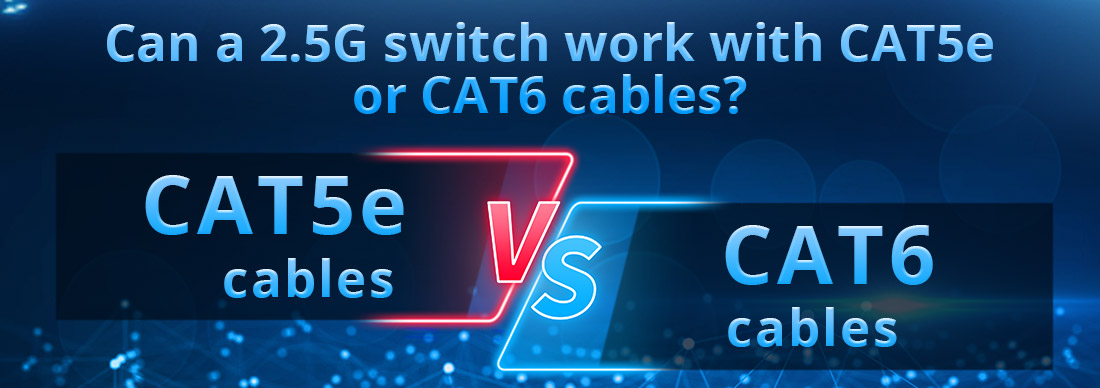
Yes, a 2.5G switch can work with both Cat5e and Cat6 cables. In fact, one of the primary advantages of 2.5G Ethernet (and 5G Ethernet, part of the same NBASE-T standard) is its ability to operate over existing copper cabling that was originally installed for 1G Ethernet, particularly Cat5e and Cat6, without the need for expensive upgrades to higher-grade cabling like Cat6a or Cat7.
Here’s a detailed breakdown of how 2.5G Ethernet works with Cat5e and Cat6 cables:
1. Cat5e Cables and 2.5G Ethernet:
Maximum Speed: 2.5 Gbps.
Maximum Distance: Up to 100 meters (328 feet).
Details:
--- Category 5e (Cat5e) is widely used for Gigabit Ethernet (1 Gbps) but can also handle 2.5G Ethernet without the need for upgrading the cabling. This is one of the key selling points for 2.5G switches in environments where Cat5e cabling is already installed.
--- Since Cat5e supports data transmission over frequencies of up to 100 MHz, it has the capability to carry higher bandwidths like 2.5 Gbps over the full 100-meter range.
--- Cost-effectiveness: Because Cat5e is inexpensive and already installed in many buildings, upgrading to a 2.5G network can be done without replacing the cabling infrastructure, making it a cost-effective solution for improving network speeds.
2. Cat6 Cables and 2.5G Ethernet:
Maximum Speed: 2.5 Gbps and even up to 5 Gbps.
Maximum Distance: Up to 100 meters (328 feet).
Details:
--- Category 6 (Cat6) cabling is designed for higher performance than Cat5e, supporting frequencies up to 250 MHz. This higher bandwidth allows it to support not only 2.5G Ethernet but also 5G Ethernet over the standard distance of 100 meters.
--- Cat6 is more commonly used in modern networks because it offers better performance and future-proofing, allowing for potential upgrades beyond 2.5G without changing the cabling again.
--- Like Cat5e, Cat6 cabling is compatible with 2.5G switches, but it can handle higher speeds more reliably in environments with electromagnetic interference (EMI) or signal noise due to its improved shielding and construction.
3. Advantages of Using Cat5e and Cat6 with 2.5G Ethernet:
Cost Savings:
--- Upgrading from 1G to 2.5G Ethernet using Cat5e or Cat6 does not require replacing existing cabling. This is one of the most significant benefits, as cable replacement (especially in large buildings or data centers) can be costly and labor-intensive.
Easy Network Upgrades:
--- With 2.5G switches, businesses and home users can get a significant speed boost without the disruptive and expensive process of rewiring for higher-end cabling (such as Cat6a or Cat7).
--- As Wi-Fi 6 (802.11ax) access points increasingly exceed 1 Gbps in throughput, 2.5G Ethernet over Cat5e or Cat6 ensures the wired backhaul can handle the higher data rates from wireless clients.
Backward Compatibility:
--- 2.5G switches are typically backward compatible with 1G and 100 Mbps standards, so they will work seamlessly with devices that are still using 1G Ethernet over Cat5e or Cat6 cables. This allows for gradual network upgrades without needing to change everything at once.
4. How 2.5G Ethernet Works Over Cat5e and Cat6:
Signal Transmission:
--- Both Cat5e and Cat6 use twisted-pair copper cabling, which reduces electromagnetic interference and maintains signal quality over longer distances. This enables them to carry 2.5 Gbps data rates without significant signal degradation up to 100 meters.
--- The key difference between Cat5e and Cat6 is their ability to handle higher frequencies. Cat6’s higher frequency capability (250 MHz) allows it to handle higher data rates like 5 Gbps more reliably over the same distance, though Cat5e can comfortably handle 2.5 Gbps.
Cross-talk and Signal Noise:
--- Cat6 offers better performance in environments with higher noise levels or more densely packed cables. Its design reduces cross-talk (interference between adjacent cables), making it more reliable for 2.5G Ethernet in settings like office buildings or data centers with a lot of cabling.
--- Cat5e can still deliver 2.5 Gbps but may not perform as well as Cat6 in high-interference environments, though for most typical office or home installations, Cat5e will suffice.
5. Limitations and Considerations:
Cable Quality:
--- Poor-quality or damaged Cat5e or Cat6 cables may not reliably support 2.5G Ethernet at the full 100-meter distance. Older or poorly installed cables, with degraded insulation or physical wear, may introduce errors or reduce throughput.
Future Proofing:
--- While Cat5e is sufficient for 2.5G, users upgrading networks may opt to use Cat6 or even Cat6a for future-proofing, as these cables are better suited for 5G or even 10G Ethernet in the future. However, for the immediate transition to 2.5G, both Cat5e and Cat6 will perform adequately.
Conclusion:
A 2.5G switch is fully compatible with both Cat5e and Cat6 cables, allowing data transmission at speeds of up to 2.5 Gbps over distances of up to 100 meters. This makes 2.5G Ethernet a highly cost-effective and convenient upgrade path for users who want to boost network performance without the need for extensive cabling replacements. Cat5e is sufficient for most 2.5G deployments, while Cat6 provides extra performance benefits and future-proofing for environments with potential for higher speeds or greater interference.